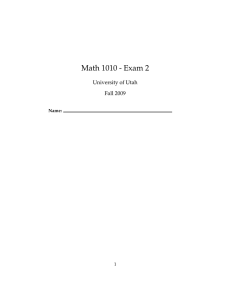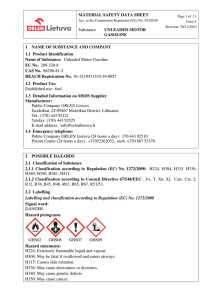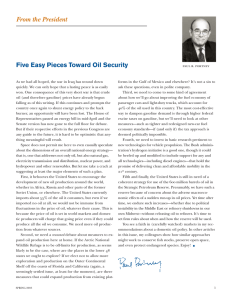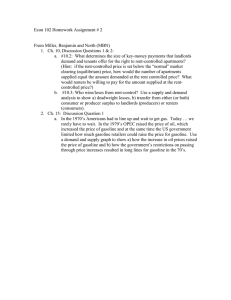Automotive gasoline (substance) MSDS
advertisement
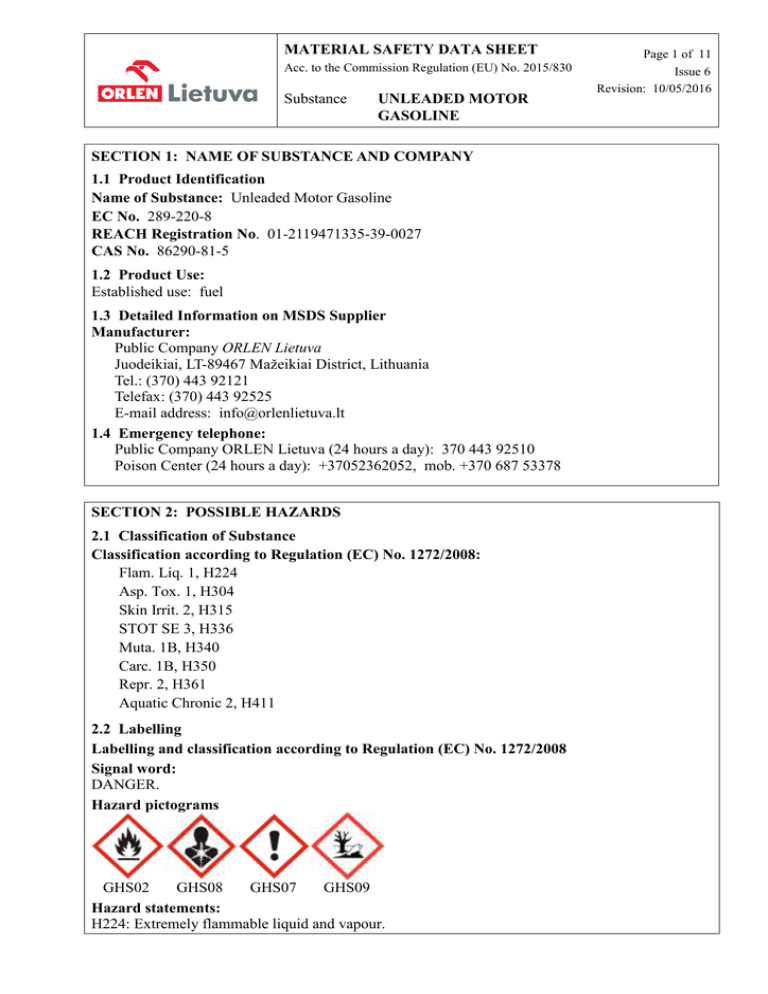
MATERIAL SAFETY DATA SHEET Acc. to the Commission Regulation (EU) No. 2015/830 Substance UNLEADED MOTOR GASOLINE SECTION 1: NAME OF SUBSTANCE AND COMPANY 1.1 Product Identification Name of Substance: Unleaded Motor Gasoline EC No. 289-220-8 REACH Registration No. 01-2119471335-39-0027 CAS No. 86290-81-5 1.2 Product Use: Established use: fuel 1.3 Detailed Information on MSDS Supplier Manufacturer: Public Company ORLEN Lietuva Juodeikiai, LT-89467 Mažeikiai District, Lithuania Tel.: (370) 443 92121 Telefax: (370) 443 92525 E-mail address: info@orlenlietuva.lt 1.4 Emergency telephone: Public Company ORLEN Lietuva (24 hours a day): 370 443 92510 Poison Center (24 hours a day): +37052362052, mob. +370 687 53378 SECTION 2: POSSIBLE HAZARDS 2.1 Classification of Substance Classification according to Regulation (EC) No. 1272/2008: Flam. Liq. 1, H224 Asp. Tox. 1, H304 Skin Irrit. 2, H315 STOT SE 3, H336 Muta. 1B, H340 Carc. 1B, H350 Repr. 2, H361 Aquatic Chronic 2, H411 2.2 Labelling Labelling and classification according to Regulation (EC) No. 1272/2008 Signal word: DANGER. Hazard pictograms GHS02 GHS08 GHS07 GHS09 Hazard statements: H224: Extremely flammable liquid and vapour. Page 1 of 11 Issue 6 Revision: 10/05/2016 MATERIAL SAFETY DATA SHEET Acc. to the Commission Regulation (EU) No. 2015/830 Substance UNLEADED MOTOR GASOLINE Page 2 of 11 Issue 6 Revision: 10/05/2016 H304: May be fatal if swallowed and enters airways. H315: Causes skin irritation. H336: May cause drowsiness or dizziness. H340: May cause genetic defects. H350: May cause cancer. H361: Suspected of damaging fertility or the unborn child. H411: Toxic to aquatic life with long lasting effects. Precautionary statements: P201: Obtain special instructions before use. P210: Keep away from heat/sparks/open flames/hot surfaces. No smoking. P273: Avoid release to the environment. P280: Wear protective gloves/protective clothing/eye protection/face protection. P331: Do NOT induce vomiting. P301+P310: IF SWALLOWED: Immediately call a Poison Center or doctor/physician. P403+P233: Store in a well-ventilated place. Keep container tightly closed. 2.3 Other hazards Unleaded Motor Gasoline is extremely flammable liquid which may generate explosive mixtures of hydrocarbon vapours and air at ambient temperatures. Vapour is irritating to skin, eyes and respiratory tract. Liquid product splashes irritate eyes and skin. Gasoline may contain up to 1 % vol. of benzene which is classified as carcinogen of 2nd category, therefore long-term exposure may cause cancer, anaemia, leukaemia and other diseases. Vapours inhaled may induce drowsiness and dizziness. Toxic to aquatic organisms. May cause long-term adverse effects to aquatic environment. Risk of soil and ground water contamination. SECTION 3: COMPOSITION/ INFORMATION ON INGREDIENTS Chemical composition: Gasoline. 3.1 Components according to Regulation (EC) No. 1272/2008: Component name Gasoline Corrosion inhibitor Antioxidant: - 2,6-Di-tert-butylphenol - 2-tert-Butyl phenol CAS No. EC No. Concentration, % m/m 86290-81-5 289-220-8 Up to 100 no date no date 0 – 0,0007 128-39-2 88-18-6 204-884-0 201-807-2 0 – 0,0025 0 – 0,0037 SECTION 4: FIRST-AID MEASURES 4.1 Description of first aid measures General Information Before attempting to rescue casualties, isolate area from all potential sources of ignition including disconnecting electrical supply. MATERIAL SAFETY DATA SHEET Acc. to the Commission Regulation (EU) No. 2015/830 Substance UNLEADED MOTOR GASOLINE Page 3 of 11 Issue 6 Revision: 10/05/2016 Ensure adequate ventilation and check that a safe, breathable atmosphere is present before entry into confined spaces. Drench contaminated clothing with water before removing to avoid risk of sparks from static electricity. Inhalation If breathing is difficult, remove victim to fresh air and keep at rest in a position comfortable for breathing. If the casualty is unconscious and: - Not breathing – ensure that there is no obstruction to breathing and give artificial respiration by trained personnel. If necessary, give external cardiac massage and obtain medical assistance. - Breathing – place in the recovery position and keep the head below the level of the torso. Administer oxygen if necessary. Obtain medical attention if casualty has an altered state of consciousness or if symptoms do not resolve. Skin Contact Immediately remove contaminated clothing and footwear and dispose of safely. Wash affected area thoroughly with soap and water. Seek medical attention if skin irritation, swelling or redness develops and persists. When using high-pressure equipment, injection of product can occur. If high-pressure injuries occur, immediately seek professional medical attention. Do not wait for symptoms to develop. For minor thermal burns: Cool the burn. Hold the burned area under cold running water for at least five minutes, or until the pain subsides. However, body hypothermia must be avoided. Eye Contact Rinse cautiously with water for several minutes. Remove contact lenses, if present and easy to do so. Continue rinsing. If irritation, blurred vision or swelling occurs and persists, obtain medical advice from a specialist. Ingestion The casualty should be sent immediately to a hospital. Do not wait for symptoms to develop. Do not induce vomiting, as there is high risk of aspiration (chemical pneumonia). Gastric lavage should be undertaken only after endotracheal intubation. Do not give anything by mouth to an unconscious person. 4.2 Most important symptoms and effects Inhalation of vapours may cause headache, nausea, vomiting and an altered state of consciousness. Skin contact – reddening, irritation. Eye contact – slight irritation (unspecific). Ingestion – few or no symptoms expected. If any, nausea and diarrhoea might occur. In case of ingestion, always assume that aspiration has occurred. 4.3 Information to doctor or other competent person providing first aid. Treatment according to symptoms. In case of ingestion, always assume that aspiration has occurred. SECTION 5: FIRE-FIGHTING MEASURES Flammability Extremely flammable liquid. 5.1 Extinguishing Media Suitable Extinguishing Media - Foam (specifically trained personnel only), - Water fog (specifically trained personnel only), MATERIAL SAFETY DATA SHEET Acc. to the Commission Regulation (EU) No. 2015/830 Substance UNLEADED MOTOR GASOLINE Page 4 of 11 Issue 6 Revision: 10/05/2016 - Dry chemical powder, - Carbon dioxide, - Inert gases (subject to regulations), - Sand or earth, - Steam. Unsuitable Extinguishing Media Do not use direct water jets on the burning product; they could cause splattering and spread the fire. Simultaneous use of foam and water on the same surface is to be avoided as water destroys the foam. 5.2 Hazards arising from the substance Combustion Products Incomplete combustion is likely to give rise to a complex mixture of airborne solid and liquid particulates and gases, including carbon monoxide and unidentified organic and inorganic compounds (H2S, SOx). Specific Hazards If tanks or containers with product are exposed to fire, there is danger of explosion due to increased pressure inside the vessel. If spillage of product occurs, the mixture of hydrocarbon vapours and air may explode or ignite of sparks or heated surfaces. Tanks and containers with product, which are in the direct vicinity of the fire, should be cooled by water jets from the safe distance. 5.3 Protective Equipment for Fire-fighters Use adequate breathing apparatus, self-contained gas masks and impervious protective clothes. In case of a large fire or in confined or poorly ventilated spaces wear full fire resistant protective clothing and self-contained breathing apparatus (SCBA) with a full face-piece operated in positive pressure mode. SECTION 6: ACCIDENTAL RELEASE MEASURES 6.1 Personal Protective Equipment and Emergency Procedures Small spillages: normal antistatic working clothes are usually adequate. Large spillages: full body suit of chemically resistant and antistatic material. Work gloves providing adequate chemical resistance, specifically to aromatic hydrocarbons. NOTE: gloves made of PVA are not water-resistant, and are not suitable for emergency use. Work helmet. Antistatic non-skid safety shoes or boots. Goggles or face shield, if splashes or contact with eyes is possible or anticipated. Respiratory protection: A half or full-face respirator with filter(s) for organic vapours or a Self Contained Breathing Apparatus (SCBA) can be used according to the extent of spill and predictable amount of exposure. If the situation cannot be completely assessed, or if an oxygen deficiency is possible, only SCBA’s should be used. Gasoline is volatile liquid with very low flash point, any spillage or leak is severe fire or explosion hazard. Stop or contain leak at the source if safe to do so. Avoid direct contact with released material. Stay upwind. In case of large spillages, alert residents in downwind areas. Keep noninvolved personnel away from the area of spillage. Alert emergency personnel. Except in case of small spillages, the feasibility of any actions should always be assessed and advised, if possible, by a trained, competent person in charge of managing the emergency. Eliminate all ignition sources if safe to do so (e.g. electricity, sparks, fires, flares). If required, notify relevant authorities according to all applicable regulations. MATERIAL SAFETY DATA SHEET Acc. to the Commission Regulation (EU) No. 2015/830 Substance UNLEADED MOTOR GASOLINE Page 5 of 11 Issue 6 Revision: 10/05/2016 6.2 Environmental Measures Spillages on to Land Stop leak at the source if safe to do so. Prevent product from entering sewers, rivers, waterways or other bodies of water. If necessary, dike the product with dry earth, sand or similar non-combustible materials. Large spillages may be cautiously covered with foam, if available, to limit fire risk. Do not use direct jets. When inside buildings or confined spaces, ensure adequate ventilation. Spillages on Water or at Sea Stop leak at the source if safe to do so. In case of small spillages in closed waters (i.e. ports), contain product with floating barriers or other equipment. If possible, large spillages in open waters should be contained with floating barriers or other mechanical means. 6.3 Cleaning Methods and Procedures Spillages on to Land Absorb spilled product with suitable non-combustible materials. Collect free product with suitable means. Transfer collected product and other contaminated materials to suitable containers for recycle, recovery or safe disposal. In case soil contamination, remove contaminated soil and treat this in accordance with local regulations. Spillages on Water or at Sea Collect spilled product by absorbing with specific floating absorbents. Mechanical means may recover, only if this is strictly necessary and if fire/explosion risks can be adequately prevented. Otherwise control the spreading of the spillage, and let the substance evaporate naturally. The use of dispersants should be advised by an expert, and, if required, approved by local authorities. Collect recovered product and other materials in suitable tanks or containers for recovery or safe disposal. Additional Information NOTE: Recommended measures are based on the most likely spillage scenarios for this material; however, local conditions (wind, air temperature, wave/current direction and speed) may significantly influence the choice of appropriate actions. For this reason, local experts should be consulted when necessary. Local regulations may also prescribe or limit actions to be taken. Spillages of limited amounts of products, especially in the open air when vapours will be usually quickly dispersed, are dynamic situations, which are unlikely to entail exposure to dangerous concentrations. However, the build-up of dangerous concentrations may occur in specific spots, like trenches, depressions or confined spaces. In all these circumstances, however, the correct actions should be assessed on a case-by-case basis. SECTION 7: HANDLING AND STORAGE 7.1 Precautions for safe handling Avoid release to the environment. Risk of explosive mixtures of vapour and air. Ensure that all relevant regulations regarding explosive atmospheres, and handling and storage facilities of flammable products, are followed. Keep away from heat/sparks/open flames/hot surfaces. No smoking. Use and store only outdoors or in a well-ventilated area. Avoid contact with the product. 7.2 Conditions for safe storage and handling MATERIAL SAFETY DATA SHEET Acc. to the Commission Regulation (EU) No. 2015/830 Substance UNLEADED MOTOR GASOLINE Page 6 of 11 Issue 6 Revision: 10/05/2016 Handling During product transfer activities (loading and unloading of mobile tanks) and during sampling there is a risk of static electrical discharge, therefore precautionary measures against static electricity shall be taken. Adequate hermetic mobile tanks should be used for gasoline transportation. Use only bottom loading of tanks/tankers/containers in compliance with European legislation. Do not use compressed air for filling, discharging, or handling operations. Ground/bond containers, tanks and transfer/receiving equipment. Use explosion-proof electrical/ ventilating/lighting equipment. Use only non-sparking tools. The vapour is heavier than the air. Beware of accumulation in pits and confined spaces. Use personal protective equipment. Avoid contact with skin and eyesDo not ingest. Avoid breathing vapours. Storage Storage area layout, tank design, equipment and operating procedures must comply with the relevant European, national or local legislation. For product storage tanks or containers with floaters (pontoons), which are suitable for storage of extremely flammable liquids, shall be used. Storage installations should be designed with adequate bunds so as to prevent ground and water pollution in case of leaks or spills. Cleaning, inspection and maintenance of internal structure of storage tanks must be done only by properly equipped and qualified personnel as defined by national, local or company regulations. Before entering storage tanks and commencing any operation in a confined area check the atmosphere for oxygen content and flammability. Gasoline vapours can build up in the headspace of tanks that may cause flammability/explosion hazards; therefore static electrical discharge and ignition sources should be avoided when measuring product level or sampling in the tanks. Store separately from oxidising agents. Recommended and Unsuitable Materials for Storage Recommended materials: For containers (tanks), or container linings use mild steel, stainless steel. Unsuitable materials: some synthetic materials may be unsuitable for containers or container linings depending on the material specification and intended use. Compatibility should be checked with the manufacturer. Container Advice lf the Product is Supplied in Containers Keep only in the original container or in a suitable container for this kind of product. Keep containers tightly closed and properly labelled. Protect from the sunlight. Light hydrocarbon vapours can build up in the headspace of containers. These can cause flammability/explosion hazards. Empty containers may contain flammable product residues. Do not weld, solder, drill, cut or incinerate empty containers, unless they have been properly cleaned. 7.3 Specific end use Gasoline is used as a fuel in spark-ignition (gasoline) internal combustion engines. SECTION 8: EXPOSURE CONTROL/ PERSONAL PROTECTION 8.1 Control parameters Exposure Limits National occupational exposure limits allowed should be observed. Where not established, the following short-term exposure limit is recommended – 300 mg/m3. 8.2 Exposure controls MATERIAL SAFETY DATA SHEET Acc. to the Commission Regulation (EU) No. 2015/830 Substance UNLEADED MOTOR GASOLINE Page 7 of 11 Issue 6 Revision: 10/05/2016 8.2.1 Technical measures During various technical and process operations gasoline vapour may be emitted into the environment, therefore the concentration in working environment air shall be controlled to the minimum allowed limit. 8.2.2 Personal Protective Equipment: Respiratory Protection If during operations the exposure of employees to large amounts of product vapour and gas is inevitable, suitable respiratory protective equipment, such as A2 filtering mask or analogous should be applied (e.g. according to EN 14387). When working in vessel internals or other confined spaces do not use filtering masks but the special self-contained protective equipment. Respiratory protection equipment should be selected and used in accordance with the manufacturer’s instructions and requirements established by the law. Eye Protection Wear safety glasses in circumstances where eye contact may occur (e.g. acc. to EN 166). Skin and Body Protection Hand Protection Wear petroleum product resistant gloves (e.g. acc. to EN 420, EN 388, EN 374-2, EN 374-3). Other Protective Measures It is necessary to wear protective clothes (e.g. acc. to EN 465) and other protection equipment. Protective clothing should be regularly inspected and maintained. Special Hygienic Recommendation Wash hands before breaks and after work. 8.2.3 Environmental Impact Control To ensure the compliance of ventilation and process equipment with requirements of environmental legal acts, emissions of such equipment are subject to check ups. In some cases vapour filtering installations or process equipment modifications may be necessary for the reduction of emission to allowed limit. SECTION 9: PHYSICAL AND CHEMICAL PROPERTIES 9.1 Information on basic physical and chemical properties Appearance clear, colourless liquid with low viscosity. Odour liquid with a typical odour of hydrocarbons. pH insignificant information. Freezing point below minus 20 oC. Distillation temperature range 30 – 210 oC. Flash point below minus 40 oC. Explosion concentration in air 1,0 – 6,0 % vol. Vapour pressure 45 – 100 kPa. Vapour density rel. to air 3 – 4. Density at 15 oC max 775 kg/m3. Solubility in water water insoluble. Auto-ignition temperature > 290 oC. Kinematic viscosity at 40 oC < 1 mm2/s. MATERIAL SAFETY DATA SHEET Acc. to the Commission Regulation (EU) No. 2015/830 Substance UNLEADED MOTOR GASOLINE Page 8 of 11 Issue 6 Revision: 10/05/2016 SECTION 10: STABILITY AND REACTIVITY 10.1 Reactivity No hazardous reaction when handled and stored according to provisions. 10.2 Stability Stable at ambient temperature. 10.3 Possibility of hazardous reactions No known hazardous reactions. 10.4 Conditions to Avoid High ambient temperature. Avoid static electrical discharges and other ignition sources. 10.5 Materials to Avoid Avoid contact with strong oxidizing agents. 10.6 Hazardous Decomposition Products Thermal decomposition products vary depending on conditions. Partial decomposition produces fume, carbon dioxide, carbon monoxide and other harmful gases. Toxic gas concentration in a confined space or premises may reach a hazardous limit. SECTION 11: TOXICOLOGICAL INFORMATION 11.1 Information on toxicological effects Sources of Exposure Gasoline may affect human body through skin, if inhaled and swallowed. Acute toxicity Experimental acute toxicity data: Acute oral LD50 > 5000 mg/kg, Acute inhalation LC50 > 5600 mg/m3, Acute dermal LD50 > 2000 mg/kg. Prolonged and sub-chronic toxicity Experimental chronic toxicity data: Short-term repeat dose dermal NOAEL 3750 mg/kg/day, Short-term repeat dose inhalation NOAEL 9840 mg/m3, Sub-chronic repeat dose inhalation NOAEL 20000 mg/m3. Acute Health Effects Vapour of low concentration is slightly irritating to eyes and respiratory system. The liquid product, when in contact with the eyes, may cause transient eye stinging or redness, and if splashed on the skin, it may slightly irritate and dry the skin. Unlikely to cause harm if swallowed in small amounts, though larger quantities may cause nausea and diarrhoea. In case of ingestion assume that aspiration has occurred. Chronic Health Effects Prolonged or repeated gasoline contact with skin may cause nausea, dizziness, headache and drowsiness; possible chemical pneumonitis. Exposure to gasoline contained benzene (when benzene content exceeds 0,1 % v/v) may result in carcinogenic effects. Exposure to gasoline contained benzene may result in carcinogenic affects to the hematopoietic system causing blood disorders including anaemia and leukaemia. MATERIAL SAFETY DATA SHEET Acc. to the Commission Regulation (EU) No. 2015/830 Substance UNLEADED MOTOR GASOLINE Page 9 of 11 Issue 6 Revision: 10/05/2016 Reproductive Toxicity Experimental Data: Toxicity inhalation NOAEC > 20000 mg/m3. NOTE. Gasoline handling under typical conditions does not pose a toxicological hazard; however, even a short deliberate inhalation of large quantity of high concentration gasoline vapour may cause loss of consciousness. SECTION 12: ECOLOGICAL INFORMATION 12.1 Ecotoxicity Gasoline is harmful to aquatic organisms, may cause long-term adverse effects in the aquatic environment. Spills may form a film on water surfaces causing physical damage to aquatic life. Experimental data: Acute aquatic invertebrate EL50 4,5 mg/l, Acute aquatic algae EL50 3,1 mg/l, Acute aquatic fish LL50 8,2 mg/l, Long-term aquatic invertebrate NOEC50 2,6 mg/l. 12.2 Durability and Degradability The product is inherently biodegradable. Volatile hydrocarbons disperse in the atmosphere. 12.3 Bio-accumulative Potential Heavier hydrocarbons of the product are possibly accumulative in aquatic organisms. 12.4 Mobility Spillage, depending on the ambient temperatures, may evaporate in significant quantities, and the rest of the spilled product may penetrate the soil and contaminate ground waters. 12.5 Results of PBT and vPvB assessment This substance no contains representative hydrocarbons structure were found to meet the PBT or vPvB. SECTION 13: WASTE MANAGEMENT 13.1 Waste Disposal Methods Waste is disposed of by de-harming it in accordance with national requirements and local regulations or via a licensed waste disposal contractor. Identify the hazards of waste handling and undertake required safety measures. Personal protective equipment is necessary for waste managing personnel. Empty tanks and tank cars may contain some remaining product; therefore, hazard-warning labels are to be retained as a guide to the safe tank handling and waste disposal. Empty containers represent a fire hazard as they may contain flammable product residues and vapour. SECTION 14: TRANSPORT INFORMATION 14.1 14.2 14.3 14.4 14.5 14.6 UN number UN proper shipping name Transport hazard class Packing group Environmental hazard Special precautions for users 1203 UN 1203, Gasoline, 3, II. 3 II Environmentally hazardous, sea pollutant. Not applicable. MATERIAL SAFETY DATA SHEET Acc. to the Commission Regulation (EU) No. 2015/830 Substance UNLEADED MOTOR GASOLINE Page 10 of 11 Issue 6 Revision: 10/05/2016 14.7 Transport in bulk according to Annex II of MARPOL 73/78 and the IBC Code No date. SECTION 15: REGULATORY INFORMATION 15.1 Legislation Lithuanian: Commission Regulation (EU) No. 2015/830; Commission Regulation (EU) No. 453/2010; Regulation (EC) No. 1907/2006 of the European Parliament and of the Council; Regulation (EC) No. 1272/2008 of the European Parliament and of the Council; Law on Chemical Substances and Preparations of the Republic of Lithuania (Official Gazette (Valstybės Žinios), 2000, No. 36-987; 2004, No. 116-4329; 2005, No. 79-2846; 2006, No. 65-2381; 2008, No. 76-3000); Order No. 532 /742; 2010, Nr. 145-7434; 2010, Nr. 157-7967; 2012, Nr. 132-6648; Teisės aktų registras, Nr. 2015-11085); Law of the Republic of Lithuania on Packing and Packing Wastes Management (Official Gazette, 2001, No. 85-2968; 2005, No.86-3206; 2008, No.71-2699; 2011, Nr. 138-6526; 2012, Nr. 6-191; 2013, Nr. 110-5429; 2013, Teisės aktų registras, Nr. 2014-00038; Nr. 2014-05579; Nr. 2016-00088); Lithuanian Hygienic Norm HN 23:2011 „Concentration Limit Values of Hazardous Chemicals in Working Environment Air. General Requirements“ (Official Gazette, 2011, Nr. 38-1804) approved by Order No. V-824/A1-389 of the Minister of Health Care and the Minister of Social Security and Labour of the Republic of Lithuania on 1 September 2011. 15.2 Chemical Safety Assessment Gasoline chemical safety assessment has been conducted. SECTION 16: OTHER INFORMATION The Material Safety Data Sheet has been reviewed and the data therein were revised and laid out according the requirements of the Commission Regulation (EU) No. 2015/830. Abbreviations and acronyms CAS Chemical Abstracts Service EC No EINECS and ELINCS Number EL50 Effect Level to 50 % of a test population EN European Standard EU European Union LC50 Lethal Concentration to 50 % of a test population LD50 Lethal Dose to 50% of a test population (Median Lethal Dose) LL50 Lethal Level to 50 % of a test population NOAEC No Observed Adverse Effect Concentration NOAEL No Observed Adverse Effect Level NOEC No Observed Effect Concentration PBT Persistent, Bioaccumulative and Toxic substance REACH Registration, Evaluation, Authorisation and Restriction of Chemicals Regulation STOT Specific Target Organ Toxicity UN United Nations vPvB Very Persistent and Very Bioaccumulative MATERIAL SAFETY DATA SHEET Acc. to the Commission Regulation (EU) No. 2015/830 Substance UNLEADED MOTOR GASOLINE Page 11 of 11 Issue 6 Revision: 10/05/2016 Hazard statements: H224: Extremely flammable liquid and vapour. H304: May be fatal if swallowed and enters airways. H315: Causes skin irritation. H336: May cause drowsiness or dizziness. H340: May cause genetic defects. H350: May cause cancer. H361: Suspected of damaging fertility or the unborn child. H411: Toxic to aquatic life with long lasting effects. Precautionary statements: P201: Obtain special instructions before use. P210: Keep away from heat/sparks/open flames/hot surfaces. No smoking. P273: Avoid release to the environment. P280: Wear protective gloves/protective clothing/eye protection/face protection. P331: Do NOT induce vomiting. P301+P310: IF SWALLOWED: Immediately call a POISON CENTER or doctor/physician. P403+P233: Store in a well-ventilated place. Keep container tightly closed. Do not use Gasoline for purposes other than indicated in the manufacturer’s information. During such use the user may be exposed to unforeseen hazards. Should you have any questions or doubts regarding the MSDS, its contents or other issues related to the material safety, please contact us at the address: info@orlenlietuva.lt NOTE. Information provided herein is considered to be accurate as of the date specified below. No warranty is made as to the accuracy or completeness of the data and information provided in this data sheet. Information provided herein serves only as guidelines for safe work, use, processing, storage, and waste management. It cannot be considered as a warranty or quality certificate. This information applies only to specific material designated and may not be suitable for such material used in combination with any other materials or in any other manner not described in this document. Public Company ORLEN Lietuva shall not be responsible for any damage or injury resulting from abnormal use of the material and from any failure to adhere to recommendations.
